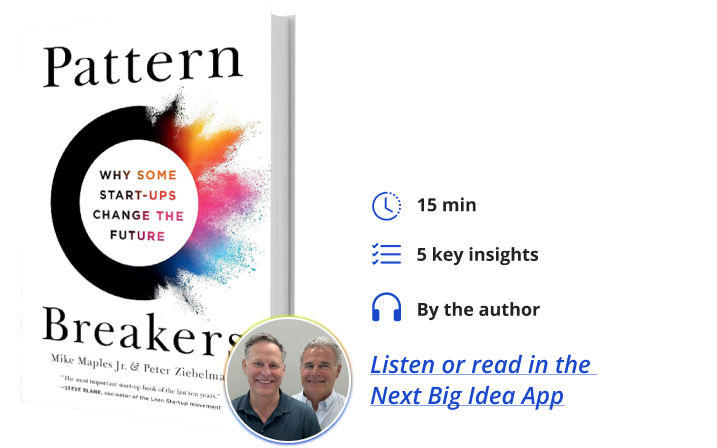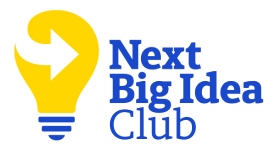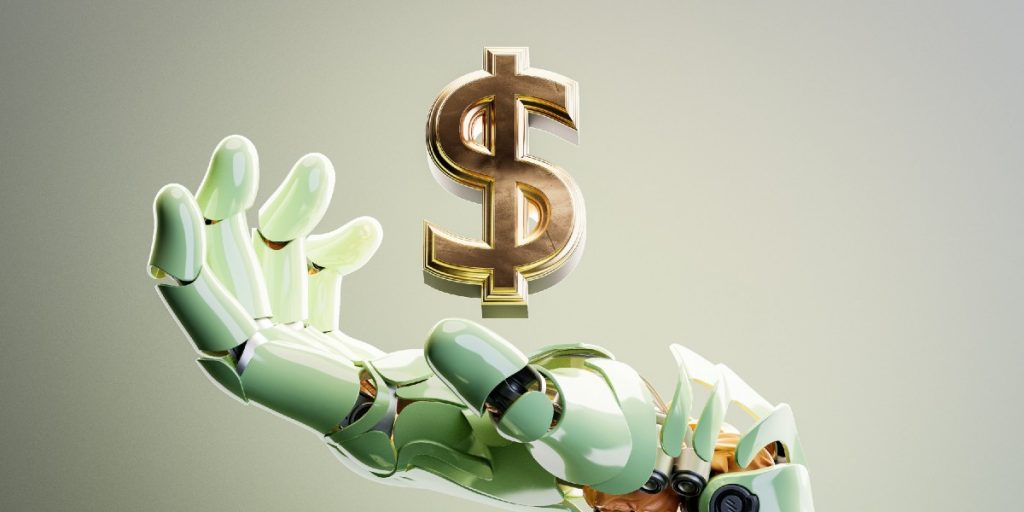Mike Maples Jr. is an entrepreneur, venture capitalist, podcast host of Pattern Breakers, and co-founder of Floodgate, a leading seed stage fund in Silicon Valley. He was one of the pioneers of the seed investing movement. His work has landed him on the Forbes Midas List of Top Venture Capital Investors eight times.
Peter Ziebelman is a lecturer in management at Stanford University’s Graduate School of Business, where he is the principal instructor for the course on entrepreneurship and venture capital. He co-founded Palo Alto Venture Partners, an early-stage venture capital firm. Ziebelman consults with Fortune 500 companies on entrepreneurship and advises start-up companies as an independent board member.
Below, co-authors Mike and Peter share five key insights from their new book, Pattern Breakers: Why Some Start-Ups Change the Future. Listen to the audio version—read by Mike—in the Next Big Idea App.

1. At first, breakthrough ideas are loved by few and hated by many.
In many ways, a breakthrough start-up is an act of rebellion. It challenges the status quo and people’s assumptions. Pattern breakers must pull people from the familiar present to an unknown future, convincing them to walk a new path.
Not surprisingly, most people dislike breakthrough ideas when they first encounter them. They are comfortable with the status quo. The thought of a different future unnerves them because they are secure in their current routines.
All great breakthroughs face doubt. In 1901, aviation was called a “useless dream” by the U.S. Navy’s chief engineer. In 1903, the New York Times said human flight might take millions of years to become real. Sixty-nine days later, the Wright brothers flew at Kitty Hawk. Galileo’s support of Copernicus’s theory that the Earth orbits the sun was met with fierce opposition and ridicule from the Catholic Church and others. He was put under house arrest for life. It took nearly two centuries for the Church to admit he was right.
Because of this, pattern breakers understand the value of seeking out the early true believers. Over time, as the new way of thinking, feeling, and acting spreads, more people come to embrace it. What was once controversial and contrarian becomes accepted wisdom.
2. Breakthroughs don’t happen without inflections.
Business is never a fair fight. The status quo usually favors established corporations and existing patterns. However, a start-up can gain an edge by leveraging inflections to radically change the rules. An inflection is a specific and powerful new change event—such as a new technology, regulation, or change in societal norms. It allows a pattern-breaking startup to create profound change.
An example of an inflection is the inclusion of a GPS chip in the iPhone 4s. This innovation enabled smartphone apps to pinpoint users’ locations with remarkable accuracy. Before this, creating a widespread peer-to-peer ridesharing network was nearly impossible due to the difficulty in locating riders and drivers. The embedded GPS chip allowed startups like Uber and Lyft to connect drivers and riders effortlessly, transforming travel.
“A start-up can gain an edge by leveraging inflections to radically change the rules.”
Inflections are all around us, yet they’re seldom leveraged by most. Why? First, most people overlook their potential because they instinctively rely on familiar patterns and habits to navigate life. Second, incumbents, despite their resources, typically ignore these shifts. The very routines and capabilities that make them strong also bias them against seeking opportunities to create radical change. But occasionally, a pattern-breaking founder sees the potential for connecting an inflection to a game-changing product that enables a groundbreaking transformation.
3. Better doesn’t matter; you have to be radically different.
Breakthrough ideas demand a radical and unconventional insight about the future. Building a better mousetrap won’t break free from old patterns and competition. A recent example is how the latest wave of AI startups created powerful products that only became obsolete when major vendors released new versions. This shows the danger of being too obvious.
True pattern breakers uncover insights to harness inflections and transform lives. Consider again ridesharing. Uber and Lyft saw that GPS in smartphones could enable car sharing, just as Airbnb had done with homes. They proved the skeptics wrong, who thought it was crazy to believe people would pay to ride in a stranger’s car. Being non-consensus is key. “Better” doesn’t lead to breakthroughs. “Different” is how startups achieve outlier success.
4. Breakthrough ideas are born in the future.
Many people misunderstand where breakthrough ideas originate. They think it’s about having a better vision of the future. Or getting struck by a sudden idea, like Newton with his apple.
However, most pattern-breaking insights come from living in the future and viscerally engaging with what’s new about it. Science fiction author William Gibson was right, “The future is already here; it’s just not evenly distributed.”
Living in the future involves experimenting and interacting with new technology inflections along with other kindred spirits. This helps pattern breakers cultivate new behaviors that escape current assumptions of thinking, feeling, and acting. As they get their hands dirty with cutting-edge technology, pattern breakers are the first to discover what’s needed for its full potential to be realized. Addressing these needs leads to powerful non-consensus insights.
“Aspiring pattern breakers can also catapult themselves to different futures by intentionally spending time with future-led individuals.”
One approach to living in the future is to immerse yourself in future technologies to solve your own problems. Marc Andreessen did this when he built an internet browser at the University of Illinois. Emmett Shear transformed Justin.tv into Twitch to improve his own experience as an avid gamer.
Another approach is solving problems for future-focused customers, as Okta’s founders did with cloud identity management by engaging with early adopters of Salesforce and other cutting-edge cloud applications. Many business-to-business startups follow this path.
Aspiring pattern breakers can also catapult themselves to different futures by intentionally spending time with future-led individuals. Maddie Hall exemplified this by becoming Sam Altman’s Chief of Staff at OpenAI. Interacting daily with Sam’s circle of confidantes and business acquaintances led her to the insights that inspired her startup, Living Carbon.
5. Great founders dare to be disagreeable.
Agreeableness is polite and easy. But it doesn’t change the world. To break patterns, you must be disagreeable. Disagreeableness protects pattern breakers from the conformity trap, which is the trap of seeking approval at the expense of achieving the mission.
For example, Logan Green and John Zimmer sidestepped San Francisco authorities when they launched Lyft. They knew asking permission would guarantee rejection, so they focused on creating something people loved first before working with the local government to craft new laws. Asking for permission would have avoided conflict but doomed the service. It would never have been allowed to launch.
We’re wired to seek approval, keep the peace, and reduce conflict. Our minds and emotions push us to conform. But disagreeableness brings the freedom necessary to keep pattern-breaking ideas alive when they are most vulnerable. The more you seek approval from the conventionally-minded, the less freedom you have to do something remarkable.
True authenticity is about finding the right balance between agreeableness and disagreeableness. Too much agreeableness makes you inauthentic, but so does too much disagreeableness. Being contrary for its own sake is just another form of conformity. And being obnoxious or a jerk isn’t brave, it’s a flaw.
To listen to the audio version read by co-author Mike Maples Jr., download the Next Big Idea App today:





























